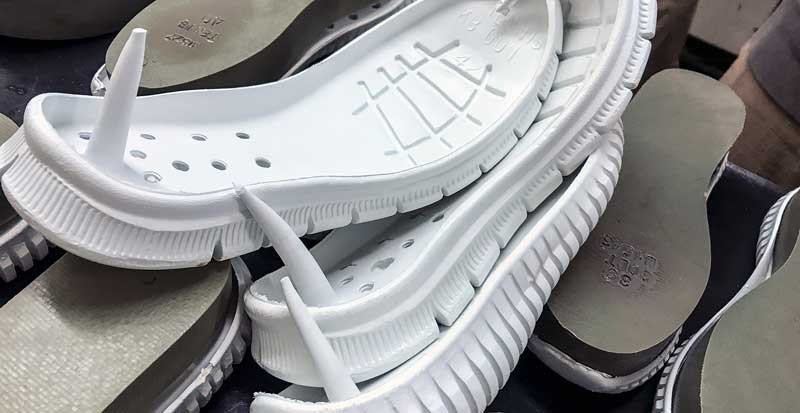


Beyond the traditional application of EVA compounds -Ethylene-vinyl acetate- for the production of molded plates for footwear and other industries, specifically the injection processing of these supplies opened the doors to a greater use in the footwear sector.
To what is used for comfort and sports footwear, it has now been added its application for fashion soles. This is due to its superior characteristics of lightness and flexibility, and the improvement of the injection systems, which have given greater control and predictability to the processes and final products.
Ethylene-vinyl acetate is a thermoplastic polymer made up of repeating units of ethylene and vinyl acetate. It is called EVA by the initials of its technical name, ethylene-vinyl-acetate.
In the footwear industry, it can be made by molding or injection, through which it is possible to obtain plates, soles, insoles, sandals, slides, midsoles and a wide variety of complementary technical articles in different models.
EVA has multiple applications in other industries, for the manufacture of bearings, seats, leather goods, technical parts, etc.

The material is offered pelletized and there are as many formulations as the requirements of each product to be made. In this regard, KBGOM together with the manufacturers analyze the characteristics and requirements of each one of them, and prepare the corresponding formulas, with different grades of rubber, polyethylene, silica and carbonates. The costs of each formula are related to the amount of ingredients needed.
With the technological advances achieved in EVA injection processes, the consumption of these materials grew exponentially for the production of soles for footwear, in all its variables, for sports, casual and fashion products.
The differentials of the components made with EVA are their extreme lightness, compared to other thermoplastics, their soft, elastic and flexible state, in addition to their appearance that is more like rubber than plastic.
The moulds for EVA are built in aluminum and their manufacture is similar for thermoplastics, only that since they are different processes -EVA is by expansion- the measurements of the moulds for EVA must be calculated exactly, since depending on the degree of expansion, the final product changes its dimensions, textures and drawings.
The characteristics of the products to be injected must be informed to the manufacturer of moulds because the size of the moulds will depend on the degree of expansion and hardness.

EVA components currently do not have sticking problems. Only the initial application of a 'primer' is necessary and then each adhesive supplier will offer the appropriate solution.
Different types of welts and accessories can be applied to EVA soles -in cold-, using the corresponding adhesives. It is also possible to carry out finishes and effects, such as paintings, engravings and finishes.
KBGOM of Argentina has recently incorporated new equipment and machinery that have allowed it to increase its production capacity to supply the local and regional market.
Currently its EVA compounds are used by the main Argentine factories of components and footwear, as well as other industries.
In Latin America, it supplies industries in different countries, especially Colombia, Peru and Ecuador, where it has specialized personnel for advice and technical assistance.
+5491153231891 – ventas@kbgom.com.ar
Ignacio Zambon - +5491154171992 – izambon@kbgom.com.ar
Carlos Galeano - +573138599705 – cgaleano@kbgom.com.ar
RELATED ARTICLES: